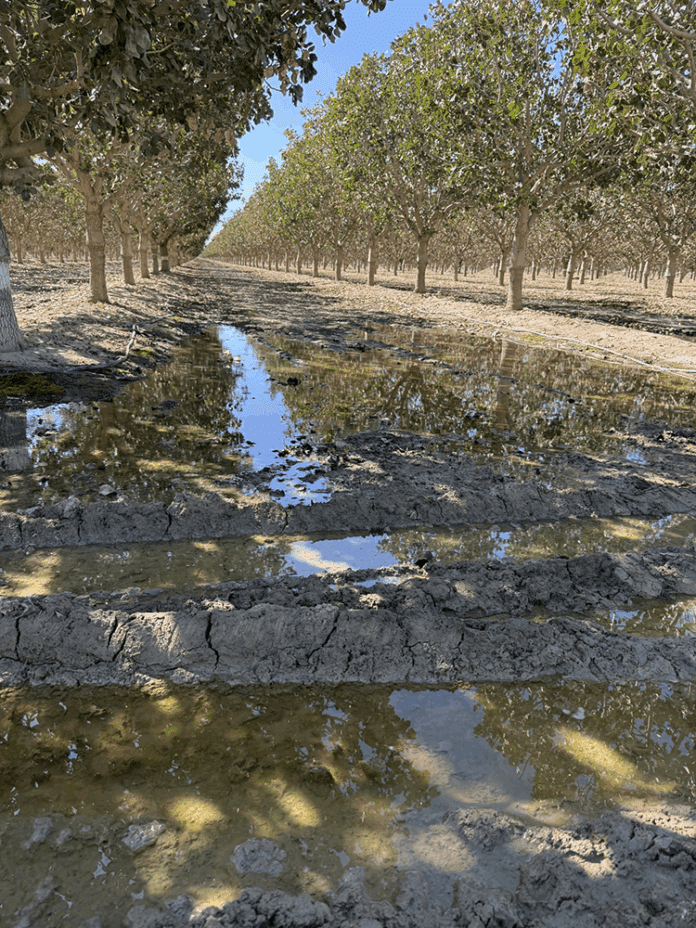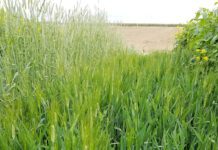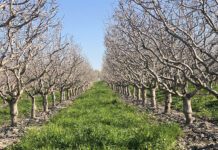
Listen to the audio version of this article. (Generated by A.I.)
Ideally, every droplet of water that goes through the irrigation system will touch the soil surface, move down and out, and supply the necessary water to plant roots. This perfect example would meet the necessary evapotranspiration of the orchard without going above or below the crops’ needs. As we all know, farming is a blend of science and art because our world is perfectly imperfect, and we must work with what Mother Nature hands us. Each field is different based on the soil structure and chemistry within, the irrigation water that is applied to it, and the management of the land. Preventing ponding in a field is important because too much water will increase the risk for soilborne diseases, affect root health and eventually disrupt the productivity of the orchard.
Understanding Soil Texture and Water Movement
When we consider the movement of water from an irrigation emitter to a root, some may think the water moves quickly to the roots, but it depends on the soil. Water moves through sandy soil much faster due to the increased pore space. This is why we see water banks being built on sandy ground; the sand can move very large volumes of water through the soil at a much faster rate than clay soil. A clay texture tends to hold onto the water more, and while there are significantly more pore spaces, each of those crevices is much smaller. Due to small and densely packed pores, it limits the movement of the water and is where growers see the largest issue of ponding in an orchard. If organic matter is low, the addition of compost can improve pore space and works best when it is incorporated into the soil.
In recent years, cover crops have been promoted and can be a great application for producing tree nut orchards. Cover crops add organic matter back into the orchard both above and below the soil surface. These crops are commonly grown in the winter and will help prevent runoff from the field through the roots soaking in water that a dormant tree would otherwise sit in during the cold winter months. The organic matter added to the soil will not only improve infiltration, but it will also support healthy soil initiatives.
‘Poor infiltration has other causes too. Commonly, high sodium content is seen in irrigated lands, which can lead to a loss of soil structure.’
Irrigation Planning and Long-Term Soil Health
Poor infiltration has other causes too. Commonly, high sodium content is seen in irrigated lands, which can lead to a loss of soil structure. Soil chemistry is vital to the health of an orchard, and the use of dihydrate gypsum (CaSO4 + 2H2O) is the industry standard to balance out the soil’s cations. It’s important to note that using true gypsum with two water molecules is key because dihydrate gypsum is significantly more soluble than anhydrite calcium sulfate. Multiple irrigations should be utilized to incorporate gypsum into the soil to leach the sodium out of the root zone. Working with an agronomist to help with the recommendation of the gypsum is important, and they may even find some calcium in the soil if lime is present. When working with an agronomist, they will typically utilize soil maps and annual soil samples when making recommendations to see if the field has variability that would affect the recommendation being made.
Have you considered that setting up your irrigation system based on soil texture will set the foundation for success? When putting in a new system, it’s very important to consider the rate at which your soil can accept the output of water. When working with an irrigation company, some good topics to touch on include the soil texture, the rate of the sprinklers or emitters, and how large the wetting pattern will be. While you may be stumped as to why there is standing water in the orchard, it may be easily solved with the amount of water being applied to the ranch, how often it is irrigated, uniformity within the field and if the system could be improved upon in the future. You may also consider if the lines were recently flushed, leaving large amounts of water on the outside edges of the field. Sometimes, an application of a cover crop seed or gypsum isn’t the answer. It could be a simple management change to improve the overall health of the orchard.
Lastly, consider the opportunity you have during the development of an orchard. I recently helped a client with a new planting where we dug soil pits to see what the roots of the trees were going to be planted in. This is the best time to amend the soil and prepare the ground for the next couple of decades at least. We noticed the soil overall was very consistent down to 5 feet, but some compaction was noticed around 2 feet. Getting a ripper into the field to break up that layer, mix in soil amendments and turn the ground would provide the best start to this soon-to-be-planted field. The grower would not have been able to do these operations five years later and was utilizing this time they had for the long-term success of the soil.
Managing the ponding of water within a field does not come with one simple answer, unfortunately. This keeps each of us on our toes, and we should continue to push each other to learn more. Whether it’s caused by high sodium, a predominantly clay soil texture, an irrigation system, a layer of compacted soil or other factors that I can’t fit into this article, we need to work together to uncover the root cause. Sometimes, it can be a mixture of reasons that should be handled concurrently. When steps are being taken to better manage our fields, we will see enhanced soil structure, reduction in disease, improved water use, boosted root health and stronger yields.















